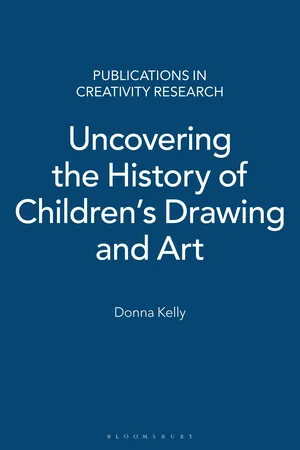
- 144 pages
- English
- PDF
- Available on iOS & Android
Uncovering the History of Children's Drawing and Art
About this book
Reactions to children's artwork have varied throughout different times and places. Donna Darling Kelly is calling for a more joyful appreciation of our youngest artists. She presents the dichotomy of the Mirror and Window paradigms. First, she explains the Mirror paradigm, which art educators, psychologists, and art historians use; it is a psychological focus on children's art. It can be defined as the ability of the child to represent images of something other than the object itself. Psychologists who believe in this theory are interested in the self-reflective qualities of children's drawing as they relate to language, intelligence, and cognitive development. The opposing Window paradigm is an aesthetic perspective followed by people working in the arts. The subscribers to this theory see children's art as an objective reproduction of reality that carries all of the meaning with the image. The act of representation is the ultimate goal in this model, not the truth behind the goal. Darling Kelly would like to see the interested parties in the field of children's art placing less emphasis on the prevailing Mirror paradigm and embrace the Window paradigm. Art educators often feel sidelined because subjects such as science and mathematics are requisites, while art remains at best, an elective. Art is often classified as a sub-discipline concerned primarily with therapeutic areas. An unwanted effect of the Mirror paradigm is the stereotypical, psychological model of the artist as a hopelessly neurotic or troubled soul. This volume is a call to arms for the aesthetic Window paradigm, so that art as an autonomous discipline can gain stature in the curriculum of all children's schools.
Frequently asked questions
- Essential is ideal for learners and professionals who enjoy exploring a wide range of subjects. Access the Essential Library with 800,000+ trusted titles and best-sellers across business, personal growth, and the humanities. Includes unlimited reading time and Standard Read Aloud voice.
- Complete: Perfect for advanced learners and researchers needing full, unrestricted access. Unlock 1.4M+ books across hundreds of subjects, including academic and specialized titles. The Complete Plan also includes advanced features like Premium Read Aloud and Research Assistant.
Please note we cannot support devices running on iOS 13 and Android 7 or earlier. Learn more about using the app.
Information
Table of contents
- 1 Introduction
- 2 Jean Jacques Rousseau (1712–1778): The “Childhood” Paradigm
- 3 Johann Heinrich Pestalozzi (1746-1827)
- 4 Friedrich Wilhelm August Froebel (1782-1852)
- 5 John Ruskin (1819-1900)
- 6 Herbert Spencer (1820-1903)
- 7 International Conference of Education (1884): Colliding Theories in Art and Education
- 8 James Sully (1842-1923)
- 9 Franz Cizek (1865-1946): “Child Art” Becomes the Window Paradigm
- 10 Second-Generation Practitioners: The Mirror Paradigm
- 11 Second-Generation Practitioners: The Window Paradigm
- Bibliography
- Index